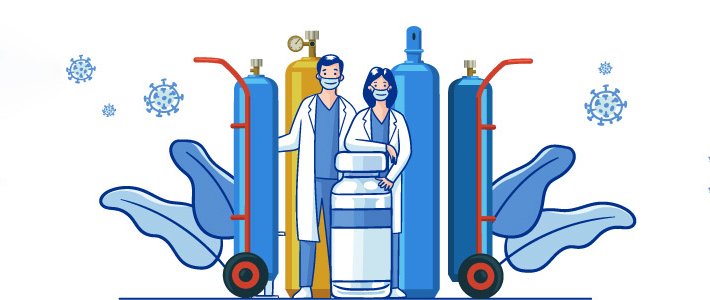Oxygen Concentrators FAQs

As we deal with this pandemic together, we, at Medi Assist, understand that oxygen therapy is the need of the moment and using oxygen concentrators for treatment has become a norm.
Recognizing the fact that not a lot of our readers know how to utilize the resources at hand, we have curated a set of instructions and FAQs to help them understand how to use and all you need to know about an oxygen concentrator.
What is an Oxygen Concentrator?
An oxygen concentrator is a machine that draws in air from the room and produces an oxygen-rich flow. The oxygen that it produces is of a lower purity than an oxygen tank. To use it, a tubing and a nasal cannula is also needed, or a simple face mask.
The benefit is that it is usually portable and doesn't use oxygen from a tank. However, they do require a reliable electricity supply, regular basic maintenance, may need a voltage converter, and may not be suitable for some patients. Please consult a doctor as to whether an oxygen concentrator is required. [1]
See this video by the American Lung Association for guidance on using an oxygen concentrator.
Important Tips before buying an Oxygen Concentrator
- Oxygen Concentration (i.e. Oxygen Purity) It should produce at least 90% oxygen concentration at the highest flow rate. It should preferably have a built-in alarm if the oxygen concentration drops below 82% (2,3).
Tip: In some lightweight oxygen concentrators, the oxygen concentration goes down as the flow rate goes up. These models are NOT recommended because they do not produce enough oxygen concentration at higher flow rates.
- Flow Rate Ideally it should have a flow rate of at least 5 - 10 liters per minute (depending on the model) and an adjustable flowmeter. [2,3] As a rule of thumb, the higher the flow rate and the larger the size, the better the concentrator. The weight of the device will give you a rough idea of the maximum flow rate.
Please follow a doctor's advice on the necessary flow rate, and adjust according to your oxygen saturation levels.
| Typical Weight | Typical Max Flow Rate |
| Light (5-10 kg) | <5 Liters per minute (Not preferred*) |
| Medium (10-20 kg) | ~5 Liters per minute |
| Heavy (20+ kg) | ~10 Liters per minute |
-
Step-Down Voltage Converter for US model oxygen concentrators
- Voltage: Convert 230 V to 110 V
- Wattage: Should support twice the wattage of the device (typically 1kW i.e. 1kVA for a 500W device). A low wattage voltage converter will not work and can cause damage to the equipment.
- Frequency: Ideally, it should convert the AC voltage frequency from 50 Hz to 60 Hz which is used in the US. However, this may not always be possible, and a regular step-down voltage converter may suffice.
-
Output Pressure It should generate at least 55 kPa of pressure at any flow rate, up to the maximum flow rate. [2, 3]
-
Backup Oxygen Tank and/or Backup Electricity Source (UPS or generator) To cover for machine breakdowns, power outages, etc., a backup oxygen tank and/or a backup electricity source such as a UPS or a generator is required. For the backup oxygen tank, calculate backup time based on flow rate and tank size.
-
Air Filter Replacement If possible, it is preferable to buy an oxygen concentrator where the air filter can be replaced easily (e.g. without having to open the back panel). Refer to the product manual for instructions on filter replacement.
What else is needed?
In addition to the concentrator, one may require the following:
- Voltage converter and plug adapter
- Backup oxygen tank (calculate backup time based on flow rate and tank size)
- Backup electricity source (generator or inverter)
- Nasal cannula, simple face mask, or non-rebreather mask (ask doctor for advice)
- Pulse oximeter (to check oxygen levels) and extra batteries for pulse oximeter
- Voltage stabilizer or surge protector
- Extra air filters
- If using a humidifier, a clean water supply (either boiled or distilled water) is necessary. Boil water for 10 minutes and cool after. Do not use a humidifier if you do not have access to boiled or distilled water.
- Tape to fix leaks
Disinfecting masks/nasal cannula and humidifier bottle (if recommended by a doctor): Although, reusing nasal cannulas or face masks is not recommended by manufacturers, this is not always practical in low-resource settings. The WHO recommends the following disinfection procedure: clean with soap and water; soak in dilute bleach solution (at least 10 parts water to 1 part bleach) for 30 minutes (or as recommended by doctor); rinse in clean water; and dry. [1, 3, 6]
How to use it?
For a quick-start guide, please refer to the Get Started with Oxygen Concentrators Checklist.
See this video by the American Lung Association for guidance on using an oxygen concentrator.
- Remember that a voltage converter that uses a US model in India may be needed.
- Check the product specifications for how long one can continuously use the concentrator. The concentrator may need to be turned off (if possible based on the patient's needs) from time to time, so please arrange for a backup oxygen tank.
How to maintain it?
Ensure Ventilation: Make sure the intake and the exhaust of the machine are not blocked, and do not place it against a wall. [1,5] The machine should be used in a well-ventilated room.
Clean outer filter twice a week: Clean the outer filter up to twice a week by washing with soapy water and drying. One can exchange it with an extra filter to use the machine continuously during cleaning. [1, 3] Replace the filter according to the product manual.
Replace Humidifier Water Daily: Using a humidifier may lead to an increased risk of microbial infections and oxygen leaks. However, if a humidifier or water bottle is recommended by a doctor, replace the water in the humidifier with distilled or boiled water daily, and disinfect the bottle weekly (and between patients) to reduce the chance of serious infections. [1, 3] If boiled or distilled water is not available, DO NOT use a humidifier.
Check For Kinks or Leaks Daily: Check for leaks daily (and after cleaning) in the tubing, connections, and nasal cannula or face mask. Also, uncurl any kinks in tubes daily as they may block the flow, and tape any holes or leaks. If possible, replace damaged tubing. [1,4]
References:
- Ti-Kay COVID-19 Oxygen Guidance
- What are the top 10 considerations when buying an oxygen concentrator?
- WHO Technical specifications for oxygen concentrators
- Ti-Kay Oxygen 101
- Oxygen Times: How to Use & Maintain an Oxygen Concentrator
- WHO Infection Prevention and Control of Epidemic- and Pandemic-Prone Acute Respiratory Infections in Health Care
- https://www.indiacovidsos.org/oxygen-faq




